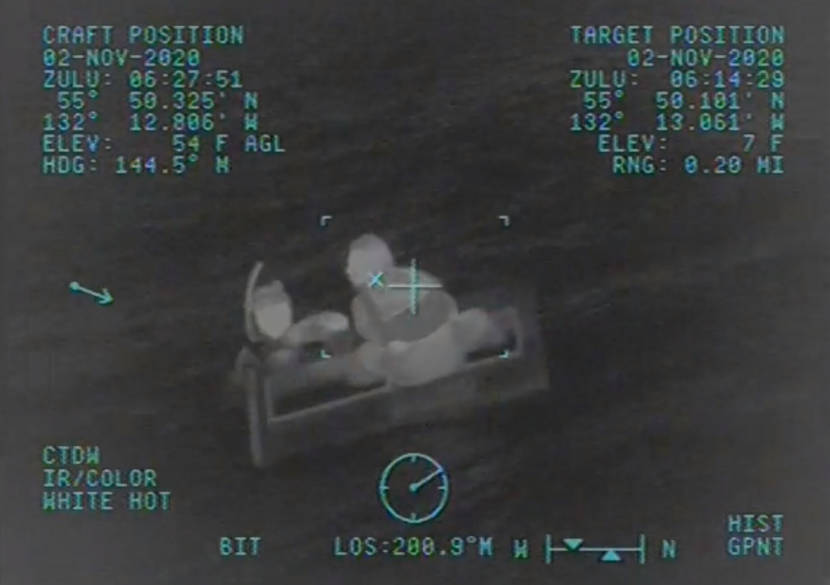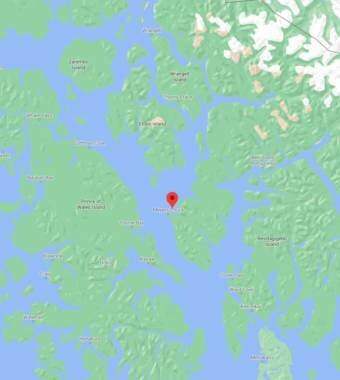
When a retired Southeast Alaska fisherman found himself adrift after his boat suddenly sank in a storm, he didn’t expect to be rescued. But a gadget on board alerted the Coast Guard, saving the 70-year-old man’s life.
For more than two hours, four members of the U.S. Coast Guard traveled in an MH-60 Jayhawk helicopter, battling blistering, 50-mph headwinds.
They were responding to an emergency signal — a boat was sinking in Union Bay.
In a Coast Guard video, crew members can be heard after spotting a lone figure clinging to a piece of debris: “We just need to get him out of there quick, the quicker the better.”

Seas were rough in the expanse of water between Ketchikan and Wrangell. Waves as tall as houses made it difficult to keep eyes on the figure, protected by a survival suit.
“As we made our approach to the flashing light, we lost sight of the survivor in the water with our cameras,” said Coast Guard pilot Lieutenant Justin Neal, who was in charge of the mission.
“We were in high winds, seas were 10 to 12 feet, trying to maintain a stable hover, and trying to relocate the survivor in the water,” Neal said. “We knew he was very close to us. But there was a moment there — maybe five minutes — where we were frantically searching with our cameras to try to find him again.”
Once the crew spotted the man again, Petty Officer Grant Roberts was lowered into the water, where he spent about 20 minutes in the pitch-dark trying to reach the man, who was clinging to something in the rolling waves.
In a video released by the Coast Guard, Roberts reaches the floating debris. Roberts helps the man into the water, and lays behind him in a sort of ‘Jack and Rose at the bow of the Titanic’ pose.
https://www.youtube.com/watch?v=iDQwCw-Xl7o
The man was 70-year-old retired fisherman Kurt Brodersen.
“It never occurred to me anybody was gonna come and get me,” Brodersen said in an interview a couple of weeks after the sinking. He says when he saw his 42-foot boat — named “Irony” — taking on water, he donned his survival suit, planning to abandon ship in the skiff. By the time he got his suit on, the skiff had sunk too.
“The hatch cover was floating off, and I got on the hatch cover,” Brodersen narrated. “My plan was to just stay there until it took me wherever the weather was going to take me. But when I got about halfway across Union Bay, I saw this red light in the sky. And I remember thinking, I wonder what those guys are doing out in these miserable conditions. After a while, I realized they were looking for me.”
Although Brodersen says he hadn’t checked the batteries in the rescue beacon in a few years, his EPIRB — Emergency Position Indicating Radio Beacon — was still working. The device automatically transmits a radio signal that rescuers hone in on.
As it went down with the ship on November 1, the EPIRB started transmitting at precisely 4:46 p.m. The Sitka-based Coast Guard helicopter crew was in the air and on the hunt within half an hour.

LTJG Jon Orthman, AST3 Grant Roberts,
AET2 Jimmy Schwader, LT Justin Neal (Courtesy U.S. Coast Guard)
Jimmy Schwader was on the mission that night. Schwader was the flight mechanic, tasked with running the winch that would raise and lower a rescue swimmer, and a survivor, if they found one.
“It was probably the worst seas that I’ve ever hoisted in,” Schwader said.
After more than three hours in the frigid bay, Brodersen was lifted out of the water. As he and rescue swimmer Grant Roberts dangled from the hovering helicopter, Schwader spooled the two up.
Lt. Neal, the aircraft commander, has been an armed forces pilot for 14 years. He says the high winds, 10-to-12-foot waves and pitch black made for one of the toughest rescues he’s ever done.
“This is probably the most challenging conditions that I’ve flown in and is absolutely the most challenging rescue that I’ve been able to prosecute,” Neal said.
The weather conditions that night made transporting Brodersen to Ketchikan for medical treatment a mission of its own. The Coast Guard crew ended up having to spend the night in Ketchikan because of dangerous wind gusts and power outages around the city.
Brodersen, the survivor, was fortunate to get to Ketchikan’s PeaceHealth Medical Center when he did. He’d had a heart attack, and was suffering from hypothermia and cold-induced rhabdomyolysis — a kind of muscle death.
He’s since been released from the hospital, but he remains in town. Doctors want to keep him nearby for observation, especially since Brodersen has epilepsy. Brodersen says epilepsy has had a profound impact on his life. He’s even captained his boat during an episode, without remembering how.
But it was no accident that Brodersen had taken his boat into open water during a storm.
After retiring from commercial fishing, Brodersen lived full-time on the Irony. The property where he would usually anchor the boat is exposed; he calls the area “The Blowhole.”
“It [gets] really bad williwaws, which are dangerous winds. If I know it’s gonna blow, I get out of there. I go up into the head of Union Bay and anchor, which I thought was supposed to be safe. Before last week, it has been [safe],” Brodersen explained.
The veteran mariner isn’t sure what went wrong on board. The anchored, steel-hulled vessel would usually be fine in rough seas.
“It’ll lay over, but then right itself because of the buoyancy of the boat. And this time, it didn’t right itself. I don’t know what happened. After a few seconds, I thought, ‘I don’t know what to do, I’m gonna start the engine and put it in gear and get bow into the weather,’ and the engine wouldn’t start. It’s the first time it’s ever failed to start. Apparently, there was already water going up the engine.”
Brodersen says he lost everything in the shipwreck: “Everything. All my records, my tax stuff, and all my clothes, everything that I had. Which is, in a way, sort of liberating because I’m starting fresh. Just the clothes that I’m wearing. The problem that I’m having is, I don’t know, I don’t exactly have a goal for the rest of my life. But you know, maybe something will occur to me.”
The Coast Guard says there’s no trace of the Irony. The only sign of the boat was the hatch cover Brodersen had clung to, and the EPIRB signal. Just the signal — the Coast Guard never found the device.
A friend offered to pay to help Brodersen search for the fishing boat that had been his home for decades. But he’s not interested in salvaging it.
“I was afraid I’d find it, and then I’d have this unholy mess to try to clean up,” Brodersen explained.
The offer of help was appreciated, though. Brodersen was stunned by how many other offers there have been since the calamity.
“In some ways,” he said, “it was one of the best events in my life. For one thing, I don’t have to do all the maintenance on the boat anymore. And for another thing, so many people tried so hard to help me, offering me places to stay, and everything really. I mean, it’s been kind of a unique event in my life.”
Brodersen says he hasn’t decided what he’ll do next. He’s still getting medical treatment in Ketchikan, and working out his epilepsy treatment. Normally, this time of year, he’d be anchored in the Zimovia Strait, looking at Wrangell Island.
“Guess I won’t be doing that anymore,” he said, laughing.
Brodersen and the Coast Guard say the somewhat miraculous rescue is really thanks to the EPIRB.
“They’re not the cheapest thing to buy, but they save lives. They work,” said Jimmy Schwader, the flight mechanic.
If you’re going out on the water, they say, make sure your EPIRB is working. Fresh batteries might just save your life.
NOTE: Mr. Brodersen has asked to not be contacted by other media.